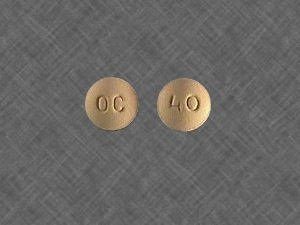Oxycontin 40 mg
This drug is prescribed to ease chronic pain (such as those caused by cancer). Oxycodone is part of a class of medications known as opioid analgesics. It acts in the brain to alter the way your body reacts to pain. The stronger strengths of this medication (more than 40 mg in a tablet) should only be taken when you've been using moderate or large doses of opioid pain medications. These strengths could result in the overdose (even the death) when taken by an individual who hasn't been taking regularly prescription opioids. Do not take the extended-release form of oxycodone to ease the pain of a mild degree or will disappear within a few days. It is not recommended to be used for only occasional ("as required") usage.
How to use Oxycontin
Take a look at the medication Guide that is provided to you by Your pharmacist before beginning to take extended-release Oxycodone and every time you receive a refill. If you have any concerns consult your physician or pharmacist.
You should take this medication on a daily schedule as prescribed by your doctor, and not when you are experiencing abrupt (breakthrough) discomfort. Use this medication in combination with or without food, typically each day for 12 hours. If you experience nausea It may be helpful to take this medication along in conjunction with food. Consult your physician or pharmacist for other methods to reduce the nausea (such such as sitting down between 1 and two hours with the least amount of head movement feasible). If nausea persists, see your doctor.
Suck the tablets up whole. Don't break or crush, chew or dissolving the tablets. This can release the entire drug in one go which increases the risk of Oxycodone excessive dose.
Side Effects
Constipation, nausea, vomiting dry mouth, sweating, weakness dizziness, lightheadedness or drowsiness can be experienced. Certain of these adverse effects can diminish when you've been taking these drug for a time. In the event that any one of these side effects persist or get worse, inform your physician and pharmacist immediately.
To stop constipation avoid constipation, consume the dietary fiber as well as drink enough fluids along with move. You might also have to use an medication to relieve constipation. Consult your doctor about which kind of laxative is appropriate for your needs.
To lessen the chance for dizziness or lightheadedness To reduce the chance of dizziness and lightheadedness, slowly get up in a standing or lying posture.
There could be an empty tablet inside your stool. This is normal since the body has already taken in the medication.
Make sure you know that your doctor prescribed this medication as they have determined that the value for you is more than the risk of adverse negative effects. The majority of patients who use this medication do not experience any serious adverse side effects.
Contact your physician immediately in case you experience any serious side effects for example: breathing problems that are interrupted while you sleep (sleep apnea) and mental/mood disturbances (such as confusion, agitation or hallucinations) or abdominal pain that is severe or difficulty urinating, symptoms of the adrenal glands that aren't functioning properly (such as a loss of appetite, excessive tiredness or losing weight).
Get medical help right away if you have any very serious side effects, including: fainting, seizure, slow/shallow breathing, severe drowsiness/difficulty waking up.
A severe adverse reaction to this medication is not common. But, you should seek medical assistance immediately if you observe any signs of an allergic reaction. These include: swelling or itching (especially of the mouth, tongue and face) and severe dizziness. difficulty breathing.
This isn't a complete list of the possible adverse effects. If you experience any other symptoms not listed above, please consult your physician or pharmacist.
Precautions
Before you take oxycodone, inform your physician or pharmacist if you're allergic to it, and to opioid pain relief medications (such as the oxymorphone) or if you are allergic to any other substances. The product could contain inactive ingredients that could trigger allergic reactions or other issues. Ask your pharmacist for further information.
Before taking this medication inform your physician or pharmacist about your medical history, particularly of the following: brain disorders (such as head injuries or tumor, seizures, etc.) or breathing issues (such as sleep apnea, asthma, chronic obstructive lung disease (COPD) liver disease, kidney disease, mental or mood disorders (such as depression, confusion) and a family or personal background of a substance-use disorder (such as an overuse or dependence on alcohol/drugs) stomach/intestinal issues (such as constipation, obstruction diarrhea caused by infections and paralytic ileus) difficulties swallowing, urinary problems (such because of an an enlarged prostate) or diseases in the pancreas (pancreatitis) or gallbladder disease.
Tags: percocet | Vicodin | Dilaudid | Concerta | Oxycodone 15mg | oxycodone 30mg | hydrocodone 10-325mg | hydrocodone 10-500mg | percocet 10-325mg | norco | ambien 10mg | adderall 30mg | methadone 5mg | roxicodone 15mg | roxicodone 30mg | oxycotin 40mg | oxycotin 80mg | tramadol 50mg | morphine 15mg | soma 350mg | MORPHINE 30MG | OPANA 20mg | LORTAB | NORCO

SearchOnlineMeds is an amazing blog to acquire all the knowledge about medicines and its uses.
ReplyDeleteorder phentermine
order percocet online without prescription
order phentermine
order hydrocodone
order adderall
order oxycodone pain killer
order opana
order ultram
order percocet online without prescription
side effects of acetaminophen and hydrocodone
We are a reputed and secure online brand that delivers online medicines like cialis 10mg , percocet 10mg, cheap viagra 50mg, neurontin overnight delivery, montelukast , yellow football xanax 1mg, verapamil 40 mg , oxycodone acetaminophen 10-325 en español and fioricet for tooth pain to your doorstep at very affordable rates.
ReplyDelete